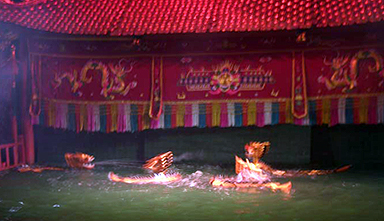30 October 2006
Puppet Regime, 2

The water puppet form was invented around 1,000 years ago in the rice paddies of north Viet Nam. Once a tradition in the flooded fields, the form is now firmly folkloric, performed in the captial on a contemporary stage flooded with water. Wooden puppets are held up on bamboo poles hidden under the water and controlled from behind a curtain at the back of the stage. Our show in Hanoi consists of 12 short vignettes along with a musical prelude.
Many of the stories take place in and around the water: fantastic tales of magical fish, swimming and spitting dragons and other animal deities, moments of legendary history, and — most interesting to me — scenes mundane, every day life. Why would people living and working in the fields need to tell a story consisting of people living and working in the fields? Is it a celebration? A means of education or identification? That this is who we are, and these are our stories? Planting rice and catching fish takes place in the same narrative space, on the same stage as the emperor who returns his sword to the giant turtle in the lake, within the same frame as the dancing dragons, mating phoenix birds and other gods of nature who tease us and manipulate the world.
After the climactic, splashing dance of the four holy animals is the curtain call. The curtain rises, the players and bamboo mechanisms are revealed — it is the puppeteers who manipulate the gods.

